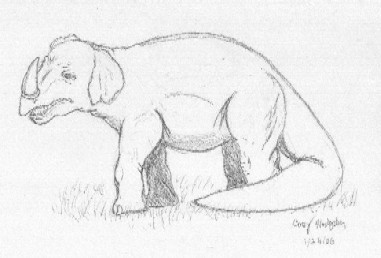
December 5, 2006
Click on above image, by Corey H., to see full-size version
Flashback and Update…
The Emela-ntouka has been an unknown animal of some confusion in Africa. A few chroniclers have felt it was merely another named cryptid representing the sightings of the Mokele-mbembe. But as revealed by a carving (below) seen here for the first time earlier this year, it appears to be a beast unlike the saurapod-like Mokele-mbembe.
On page 219 of one of my recent field guides, written with Patrick Huyghe, we noted, among several different kinds of alleged “dinosaurs” in Africa, “one animal is called by locals the emela ntouka, or ‘killer of elephants.’ The semi-aquatic Emela-ntouka is described as more rhinoceros-like than the Mokele-mbembe, with a single horn that protrudes from its head.”
In 1981, Dr. Roy Mackal while searching the Congo for the Mokele-mbembe, collected accounts of these Emela-ntouka. The natives in the northwest region of the Likoula (per the M’boshi and French, but Likouala in most English text) swamp told him that this animal would gore elephants with its single horn. Mackal initially considered that Emela-ntouka might be a Centrosaurus (“pointed lizard”) of the Ceratopsian family (formerly the Monoclonius). But he also noted the pygmies did not report a neck frill, which he would have expected on a ceratopsian.
I have long speculated in writing, and wondered aloud if there might be an unknown new subspecies or species of aquatic rhinoceros in the Cameroon-Congo area, captured in the folklore of the Emela-ntouka.
Troubling in the identification has been the long tail seen on the Emela-ntouka. Rhinos have short tails. Disturbing to the ceratopsian school has been the lack of a neck frill, and the dubious survival of dinosaurs into modern times.
Click on image for larger size
Copyright: Michel Ballot – Mokélé – Mbembé CAMEROUN 2004
Earlier this year, I obtained permission to publish French cryptozoologist Michel Ballot’s photograph of a wooden native representation of Emela-ntouka he discovered in Cameroon. This image is from his forthcoming 2007 (see below) book on his Mokele-mbembe expeditions.
Founder of the Cryptos Center, now replaced by the AFRC (association française de recherche cryptozoologique), Ballot is its secretary-general of exploration.
Ballot first came upon this Emela-ntouka sculpture in a zone of northern Cameroon, along the border with the Central African Republic. He located it at the time of his second search for indications of current or recent activity of a very large amphibious animal in the area. The French cryptozoologist has explored this region since the beginning of 2004, three times, in the hopes of finding links to the Mokele-mbembe activity in the Congo. His forthcoming book will overview his findings.
The sculpture is the first good three-dimensional native representation, as far as we know, ever seen in the West of the Emela-ntouka. Clearly shown is Emela-ntouka’s long tail and single horn in this unique piece of African art. But here too, you can see that there is no neck frill. What do appear to exist, and are graphically shown, are small, elephant-like ears, different than found on rhinoceros or allegedly on dinosaur.
This Emela-ntouka sculpture is a wonder to behold, with more new questions than answers, perhaps. Please comment on what you see from examining it, as did one reader who sketched the drawing at the top.
Thanks to Michel Ballot for sharing this image, which he has strictly copyrighted due to his forthcoming book’s publication.
Update: French cryptozoologist Jean luc Drevillon has contacted me sharing the information that Michel Ballot’s book is now due out in 2007; the publisher is Les 3 spirales. By strange coincidence, I have been informed, 5 Dec 2006, Michel Ballot’s wife just gave birth to a baby girl today. Congratulations to the Ballot family.
About Loren Coleman
Loren Coleman is one of the world’s leading cryptozoologists, some say “the” leading living cryptozoologist. Certainly, he is acknowledged as the current living American researcher and writer who has most popularized cryptozoology in the late 20th and early 21st centuries.
Starting his fieldwork and investigations in 1960, after traveling and trekking extensively in pursuit of cryptozoological mysteries, Coleman began writing to share his experiences in 1969. An honorary member of Ivan T. Sanderson’s Society for the Investigation of the Unexplained in the 1970s, Coleman has been bestowed with similar honorary memberships of the North Idaho College Cryptozoology Club in 1983, and in subsequent years, that of the British Columbia Scientific Cryptozoology Club, CryptoSafari International, and other international organizations. He was also a Life Member and Benefactor of the International Society of Cryptozoology (now-defunct).
Loren Coleman’s daily blog, as a member of the Cryptomundo Team, served as an ongoing avenue of communication for the ever-growing body of cryptozoo news from 2005 through 2013. He returned as an infrequent contributor beginning Halloween week of 2015.
Coleman is the founder in 2003, and current director of the International Cryptozoology Museum in Portland, Maine.
Filed under Books, Breaking News, Cryptomundo Exclusive, CryptoZoo News, Cryptozoologists, Cryptozoology, Evidence, Expedition Reports, Extinct, Eyewitness Accounts, Folklore, Lake Monsters, Living Dinosaurs